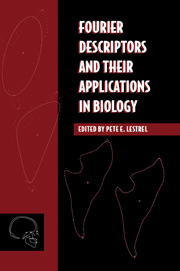Book contents
- Frontmatter
- Contents
- List of contributors
- Preface
- Acknowledgments
- Part one Theoretical considerations
- Part two Applications of Fourier descriptors
- 6 Closed-form Fourier analysis: A procedure for extraction of ecological information about foraminiferal test morphology
- 7 Fourier descriptors and shape differences: Studies on the upper vertebral column of the mouse
- 8 Application of the Fourier method on genetic studies of dentofacial morphology
- 9 Fourier analysis of size and shape changes in the Japanese skull
- 10 Craniofacial variability in the hominoidea
- 11 Heuristic adequacy of Fourier descriptors: Methodologic aspects and applications in Morphological
- 12 Analyzing human gait with Fourier descriptors
- 13 Elliptic Fourier descriptors of cell and nuclear shapes
- 14 Cranial base changes in shunt-treated hydrocephalics: Fourier descriptors
- 15 A numerical and visual approach for measuring the effects of functional appliance therapy: Fourier descriptors
- 16 Size and shape of the rabbit orbit: 3-D Fourier descriptors
- 17 From optical to computational Fourier transforms: The natural history of an investigation of the cancellous structure of bone
- 18 Epilogue: Fourier methods and shape analysis
- Appendix
- Glossary
- Index
9 - Fourier analysis of size and shape changes in the Japanese skull
Published online by Cambridge University Press: 14 September 2009
- Frontmatter
- Contents
- List of contributors
- Preface
- Acknowledgments
- Part one Theoretical considerations
- Part two Applications of Fourier descriptors
- 6 Closed-form Fourier analysis: A procedure for extraction of ecological information about foraminiferal test morphology
- 7 Fourier descriptors and shape differences: Studies on the upper vertebral column of the mouse
- 8 Application of the Fourier method on genetic studies of dentofacial morphology
- 9 Fourier analysis of size and shape changes in the Japanese skull
- 10 Craniofacial variability in the hominoidea
- 11 Heuristic adequacy of Fourier descriptors: Methodologic aspects and applications in Morphological
- 12 Analyzing human gait with Fourier descriptors
- 13 Elliptic Fourier descriptors of cell and nuclear shapes
- 14 Cranial base changes in shunt-treated hydrocephalics: Fourier descriptors
- 15 A numerical and visual approach for measuring the effects of functional appliance therapy: Fourier descriptors
- 16 Size and shape of the rabbit orbit: 3-D Fourier descriptors
- 17 From optical to computational Fourier transforms: The natural history of an investigation of the cancellous structure of bone
- 18 Epilogue: Fourier methods and shape analysis
- Appendix
- Glossary
- Index
Summary
Introduction
Morphological changes in Japanese cranial and facial form over time were described by Suzuki (1967). He examined a sample (n = 542) from the Jomon (Neolithic) through the Early Modern (Historic) period. These cranial materials were identified as adult males free from any congenital malformations or artificial deformations.
Suzuki described the face of a typical protohistoric Japanese as long headed, with a broad face, wide and flat nasal roots, and a fairly strong prognathism. These morphological aspects gradually changed becoming round-headed, displaying a more constricted face, and narrower and higher nasal roots, and less prognathous jaws. Nevertheless, two characteristics associated with the protohistoric period, dolichocephaly and prognathism, remained quite pronounced.
Some of the contributing factors influencing these chronological changes in skull morphology were hypothesized to be socioeconomic and environmental (Suzuki, 1967). Another presumed factor was the choice of mate. Finally, he also suggested that differences in Japanese physiognomy (as seen in these craniofacial or physical characteristics) from prehistoric to modern times were due to diverse origins. His studies were based on metrical and nonmetrical observations as well as physical measurements taken from the Martin and Saller (1957) handbook.
Traditionally, skull form has been described with ratios or indices as introduced by Martin and Saller (1957).
Information
- Type
- Chapter
- Information
- Fourier Descriptors and their Applications in Biology , pp. 210 - 226Publisher: Cambridge University PressPrint publication year: 1997
Accessibility standard: Unknown
Why this information is here
This section outlines the accessibility features of this content - including support for screen readers, full keyboard navigation and high-contrast display options. This may not be relevant for you.Accessibility Information
- 3
- Cited by
